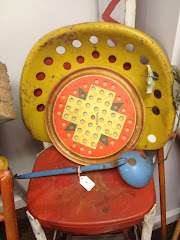Tips From The Editor of I Antique Online.com About How To Clean Out Your Basement
Getting ready to downsize a house is a BIG step c

ouples take. I know first hand what it is like to venture into your basement and stare at 30 years plus of stuff! The good news is that I have already made a dent in the clean up process. Years ago I unloaded the cribs, high chairs, and kid junk.
Saving Binkies: Are You Kidding?
Well perhaps I am not being totally honest here a

bout holding onto kid junk.. I mean I do still have plastic boxes filled with every report card, book report and handmade card that my kids brought home. Why on earth do we all keep all this old paper? The answer is nostalgia. Yesterday I was cleaning out an old desk drawer and I found three rubber baby binkies from the last kid. He is twenty now. Do you think he really wants to inherit his old pacifiers?
Staying Sane When Downsizing Your House
O.K back to the subject of downsizing. How

do you accomplish this task and stay sane. First you need a strategy and then you need supplies. To accomplish your goal you will need to set a realistic schedule. Now don't panic. Just because it took thirty years to get all stuffed up with junk, does not mean it will take thirty years to liquidate the load. But it will take time, so be prepared.
Step One: Get the supplies you need to be able to unload the stuff.
Supplies
1. giant industrial strength black plastic bags
2. plastic storage boxes
3. cardboard boxes from liquor store
4. giant zip lock plastic bags
5. brown paper shopping bags from grocery store
Step Two: Enlist help: Do Not Do This Yourself
If

you are a baby boomer with a bad back or a couch potato with aches and pains....do not attempt to clean out thirty years of stuff by yourself. Hire a high school kid or handyman or bribe your kids, but get help with the clean out! You will need help getting things off high shelves, carrying bags of garbage to trash bins, bundling bags of like items etc. Basically you need a stuffer/sshlepper.

Step Three: Begin Creating a List of Categories
You will need to know ahead of time what is going where. Here are some common categories to consider.
Categories For Junk Liqu idation
idation
1. clothes to give away to charity
2. garbage
3. toys to give away to charity
4. books to donate to library
5. collectibles to sell
6. bric a brac to bring to Salvation Army or Goodwill etc.
7. Linens, blankets, toiletries etc. to bring to a shelter.
8. keepsakes to offer to family members.
9. junk to bring to dump yard .
10. Antiques and valuables to sell.
11. family photos and memorabilia to hold onto .
12. Broken or outdated furniture and appliances to junk.
13. old files to shred.
Step Four: Begin Sorting Out Junk
With help, I hope, you can set up your boxes and bags in the basement and start sorting out what you have into like categories. Be sure to label the boxes and bags so you know what is going where.
Once you start categorizing items, put the similar boxes and bags together in ceratin areas of your basement. Be careful not to mix up good stuff from garbage. Did I just say that? It's all JUNK isn't it?
Be sure to visit my site:
C. Dianne Zweig is the author of Hot Kitchen & Home Collectibles of the 30s, 40s, 50s and Hot Cottage Collectibles for Vintage Style Homes. She is also the Editor of
I Antique Online an actively growing internet based resource community for people who buy, sell or collect antiques, collectibles and art. You can find Dianne’s fabulous retro and vintage kitchen, home and cottage collectibles at The Collinsville Antiques Company of New Hartford, CT, a 22,000 feet antique emporium with an in-house retro café.To read more articles by C. Dianne Zweig click on this link:
C. Dianne Zweig’s Blog Kitsch ‘n Stuff Email me at
dianne@cdiannezweig.comVisit my website,
CDianneZweig.comDianne is a member of:The American Society of Journalists and AuthorsThe Society of Professional Journalists










 iscovered this excellent non profit organization called
iscovered this excellent non profit organization called 



























